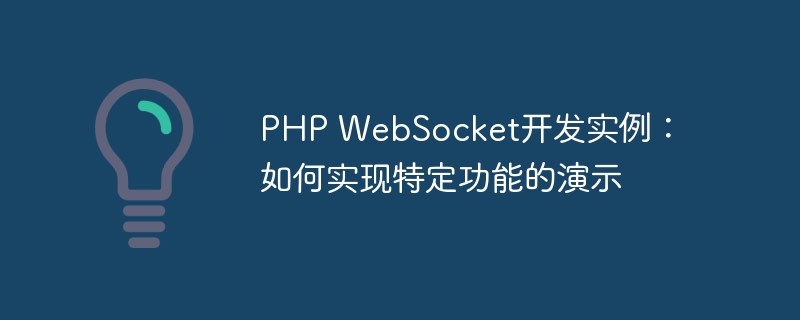

PHP WebSocket development example: demonstration of how to implement specific functions
WebSocket is a protocol for real-time two-way communication, which enables the establishment of Persistent connections are possible. WebSocket is a powerful tool for web applications that need to implement real-time functionality or instant communication. In this article, we will demonstrate how to use PHP WebSocket development and implement specific functions.
Create WebSocket Server
First, we need to create a WebSocket server. In PHP, we can use the Ratchet library to implement a WebSocket server. First, install the Ratchet library through Composer:
composer require cboden/ratchet
Then, create a server.php file that defines our WebSocket server:
<?php
require __DIR__ . '/vendor/autoload.php';
use RatchetServerIoServer;
use RatchetHttpHttpServer;
use RatchetWebSocketWsServer;
class MyWebSocketServer implements RatchetMessageComponentInterface {
// 实现WebSocket服务器的方法
}
$server = IoServer::factory(
new HttpServer(
new WsServer(
new MyWebSocketServer()
)
),
8080
);
$server->run(); In this example, We created a class named MyWebSocketServer to implement the interface methods of the WebSocket server. This class will handle received messages, connection and close events, etc.
In the MyWebSocketServer class, we add the following methods to handle message, connection and close events:
class MyWebSocketServer implements RatchetMessageComponentInterface {
protected $clients;
public function __construct() {
$this->clients = new SplObjectStorage();
}
public function onOpen(RatchetConnectionInterface $conn) {
$this->clients->attach($conn);
echo "New connection! ({$conn->resourceId})
";
}
public function onClose(RatchetConnectionInterface $conn) {
$this->clients->detach($conn);
echo "Connection {$conn->resourceId} has disconnected
";
}
public function onMessage(RatchetConnectionInterface $from, $msg) {
foreach ($this->clients as $client) {
$client->send($msg);
}
}
public function onError(RatchetConnectionInterface $conn, Exception $e) {
echo "An error has occurred: {$e->getMessage()}
";
$conn->close();
}
}In the above code, we use SplObjectStorage to store all clients connected to the server. When there is a new connection, we save it to $clients and print out the resource ID of the new connection. When the connection is closed, we remove the disconnected client from $clients and print out its resource ID. When a message is received, we loop through all connected clients and send the message to each client.
Run the server
Now, we have the WebSocket server and service logic ready. We can start the server by running the following command:
php server.php
The server will listen to port 8080 and start receiving and processing client connections, messages, and shutdown events.
var socket = new WebSocket("ws://localhost:8080");
socket.onopen = function() {
console.log("Connected to server");
};
socket.onmessage = function(event) {
console.log("Received message: " + event.data);
};
socket.onclose = function() {
console.log("Server connection closed");
};
// 发送消息
function sendMessage(message) {
socket.send(message);
}With the above code, we can connect to our WebSocket server and send a message by calling the sendMessage function. When a message is received, the message content is printed in the browser's console.
Through this example, we demonstrate how to use PHP WebSocket development and implement a simple chat room function. Of course, WebSocket has a wider range of uses in practical applications, and you can implement more complex functions according to your own needs.
To sum up, this article demonstrates how to use PHP WebSocket development to implement demonstrations of specific functions. I hope this example will be helpful for you to understand and learn PHP WebSocket development.
The above is the detailed content of PHP WebSocket development example: demonstration of how to implement specific functions. For more information, please follow other related articles on the PHP Chinese website!




